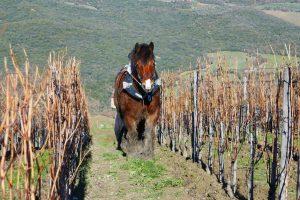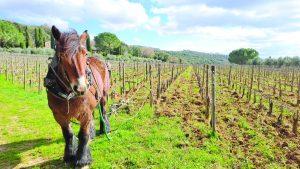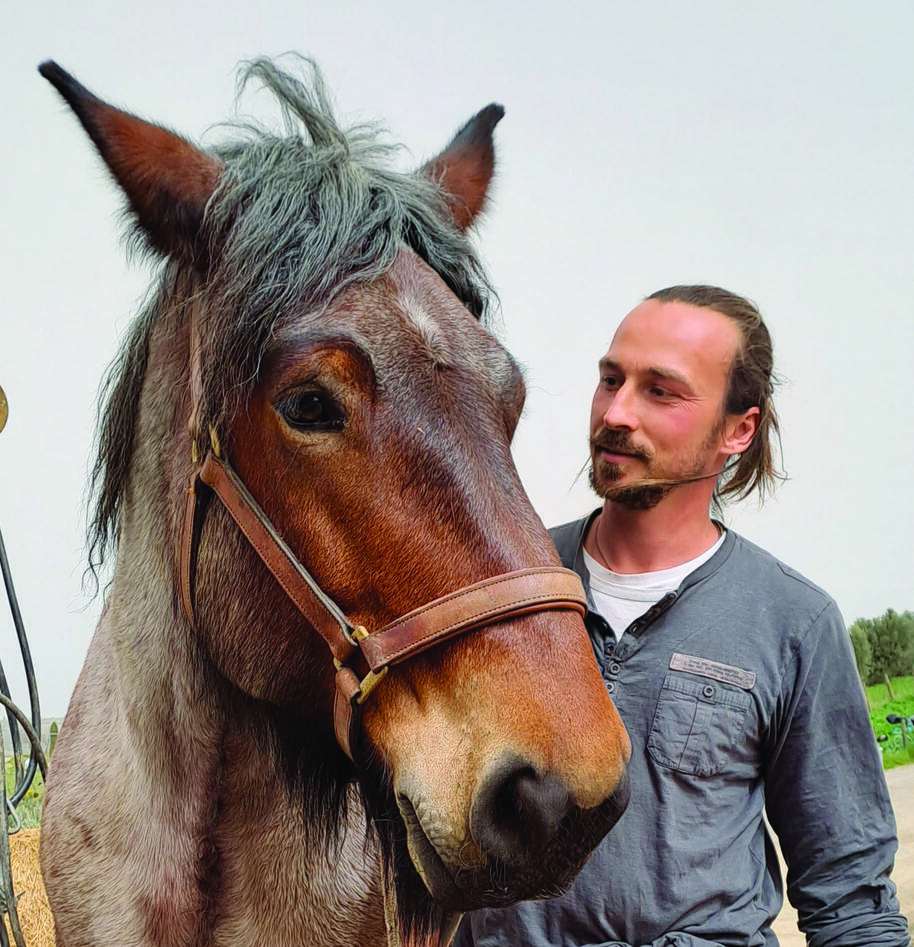By Jori Diego Cherubini
There is an ancient and at the same time new way to better manage the work in the vineyard: the plough horse. The idea was born in Burgundy, to fix vines that were even a century old, and Axel decided to (ex)bring the (brilliant) idea to Tuscany. We talked to him about it.

“The problem of the tractor,” says Axel, “concerns soil compaction: being a heavy vehicle, the repetitive steps damage the soil, the porosity of the soil and the rooting of the plant, since the vineyard needs deep roots, the deeper they are, the more it will be able to express the terroir in the grapes and, consequently, in the wine; and can survive drought. The horse, in addition to helping the plant to have a healthy space, is slower and more precise than the tractor: like a carpenter who builds a piece of furniture by hand, it takes time, four times more than an agricultural vehicle, but there is an unrivalled craftsmanship, the plants are checked one by one, and they are not hit.”
The busiest period is spring, until June, then there is the grape harvest. Many winegrowers choose horses for harvesting grapes, but also for pruning or natural treatments: “The animal,” Axel continues, “is a tool that makes sense in many conditions, it does not mean replacing the tractor, but in certain contexts the horse’s motive power is preferable. The hoe was the first tool used by man in agriculture; It doesn’t mean that since we invented the tractor we have to throw it away.”
 In Montalcino: “I worked in a terraced vineyard, with a passage of only one meter then there was a void, a danger faced without problems by the horse. In Castelnuovo Berardenga: “in a ‘sapling’ vineyard, the shoots went into the inner row and the tractor broke them; The problem was solved thanks to the horse, which made it possible to tackle the work without ruining the roots.”
In Montalcino: “I worked in a terraced vineyard, with a passage of only one meter then there was a void, a danger faced without problems by the horse. In Castelnuovo Berardenga: “in a ‘sapling’ vineyard, the shoots went into the inner row and the tractor broke them; The problem was solved thanks to the horse, which made it possible to tackle the work without ruining the roots.”
The animals, beautiful and majestic, come from France, are 8 and 9 years old and weigh almost a ton: “It’s a draft breed, born for work and you can tell by the bone structure, they want to go, it’s a habit, they never resist. Each of them has a character, and a daily relationship is created, we are together eight hours a day.”
 In Italy Axel, French but Tuscan by adoption, is almost the only one to carry out this type of work: «Beyond the Alps it is a very widespread practice compared to Italy, it is a technical work that requires knowledge on horses, land, equipment, times and methods; Every condition is different, it takes passion and years of practice, but the satisfaction is great. To date,” he points out, “I work for half a dozen selected companies.”
In Italy Axel, French but Tuscan by adoption, is almost the only one to carry out this type of work: «Beyond the Alps it is a very widespread practice compared to Italy, it is a technical work that requires knowledge on horses, land, equipment, times and methods; Every condition is different, it takes passion and years of practice, but the satisfaction is great. To date,” he points out, “I work for half a dozen selected companies.”
The ecology side has its value: “you don’t pollute, and on an agronomic level, in addition to not compacting the soil, let’s be precise, then there is a component of visual/aesthetic pleasure that coincides with the vision of an animal in the middle of a row, children also like it a lot and you can perceive a different energy”. Animal traction is a tool to add to your toolbox. “It is a time, ours, where slowness must be valued, the horse enters this context of philosophical change.”
A thank you to Podere Forte: «the owner Pasquale Forte was the first to believe in this work, being a new thing there was some mistrust». Here are the companies that rely on Axel: «in Montalcino I work for the Màté Winery; in Chianti for the winemaker Giovanna Morganti of Podere le Boncie; in Castiglione d’Orcia for the Forte farm; in Siena for Jem Macy, an American who cultivates a grape variety to produce a few bottles of wine called Le Fanciulle». In short, excellence chooses horses.

Info: Caval’Tiro – Axel, Tel. +39 392/2441281 | cavaltiro@gmail.com | Facebook: Caval’Tiro
